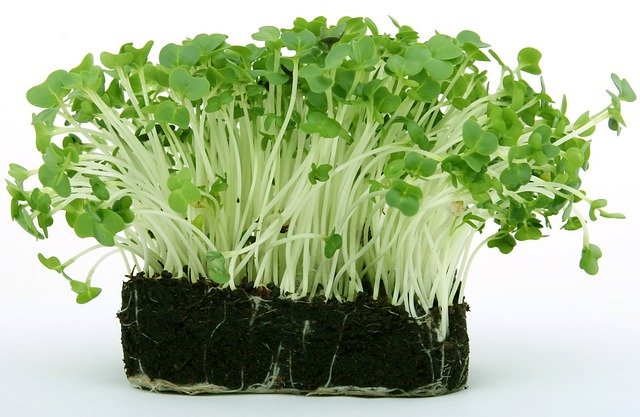
Microgreens may be small, but they pack a serious punch when it comes to flavor and nutrition. In case you don’t know what they are, microgreens are young, edible seedlings that are harvested just after the first true leaves appear, which is usually within 7 to 14 days of germination. And while they may look delicate, they’re incredibly rich in nutrients, sometimes even more so than their full-grown counterparts.
Whether you want to grow them at home, pick them up at your local market, or just understand what all the fuss is about, this guide will walk you through what makes microgreens so powerful – and how to use them.
What Are Microgreens?
Microgreens are the tender shoots of vegetables and herbs that are harvested in their early stages – typically 1 to 3 inches tall, just after the cotyledon leaves (the first set) have opened and the first “true” leaves begin to form.
At this stage, the plant is going through rapid growth and development, and that’s where the nutrient density comes in.
Are They Still Good After 3 Inches?
Great question! In fact, it’s one that I had, as my dad often grows microgreens and has so much to share with us that sometimes they grow pretty big before we cut them. I was wondering if it was still worth eating them, so I did some research. It turns out that technically, microgreens that grow past the 3-inch mark begin transitioning into “baby greens.” As they grow larger, the flavor can become stronger or more bitter, and the texture may turn tougher or stringier, making them less ideal for delicate dishes. But I still enjoyed eating them.
Nutritionally? They’re still good for you! That made me very happy. They don’t lose nutritional value by growing taller, but they may not be as nutrient-dense per gram as they were in their micro stage. That’s why microgreens are prized: they’re small, but concentrated sources of vitamins, minerals, and antioxidants.
Why Are Microgreens So Good for You?
Here’s the fun part: microgreens can contain up to 40 times more nutrients than their mature plant versions (according to a study by the USDA and University of Maryland). That means just a handful of microgreens might give you a serious dose of nutrients you’d normally need to eat a whole plate of veggies to get.
Common Benefits of Microgreens:
- High in vitamins A, C, E, and K
- Rich in antioxidants, which help fight inflammation and cellular damage
- Good source of minerals like calcium, magnesium, iron, potassium, and zinc
- Contain polyphenols and phytonutrients linked to heart health, brain health, and reduced cancer risk
- Provide chlorophyll, which supports detoxification and digestion
Nutrients by Type: What Each Microgreen Offers
Different types of microgreens offer different nutrients, so mixing it up is a great idea. Here’s a quick breakdown:
| Microgreen | Flavor | Key Nutrients |
|---|---|---|
| Broccoli | Mild, slightly peppery | Sulforaphane, Vitamins C, K, E, Lutein |
| Radish | Spicy, sharp | Vitamin C, folate, glucosinolates |
| Kale | Earthy, mild | Vitamins A, C, K, calcium, antioxidants |
| Beet | Earthy, slightly sweet | Iron, magnesium, potassium, betalains |
| Pea shoots | Sweet, crisp | Vitamins A, C, folate, protein |
| Sunflower | Nutty, crunchy | Vitamin E, healthy fats, selenium |
| Arugula | Peppery, spicy | Vitamin K, calcium, glucosinolates |
| Cilantro | Fresh, citrusy | Vitamins A, C, potassium |
| Basil | Sweet, aromatic | Vitamin K, manganese, antioxidants |
Pro tip: Combining a few types of microgreens in your meals means you’ll get a broader range of nutrients and flavors.
Growing Microgreens at Home
Growing microgreens is relatively simple and requires minimal space:
- Select Seeds: Choose organic seeds labeled for microgreen production.
- Prepare a Growing Medium: Use a shallow tray filled with a soilless potting mix.
- Sow Seeds Evenly: Distribute seeds uniformly across the surface and lightly press them into the medium.
- Water and Cover: Mist the seeds with water and cover the tray to block light until germination occurs.
- Provide Light: Once sprouts appear, expose them to light for healthy growth.
- Harvest: Use clean scissors to cut microgreens just above the growing medium when they reach the desired height.
Don’t Want to Grow Them? Here’s How to Buy Them
If growing your own isn’t your thing, no problem. You can absolutely enjoy microgreens without getting dirt under your nails.
Where to Find Microgreens:
- Farmers Markets: Look for local growers who sell fresh trays or cut microgreens. These are often the freshest and most flavorful.
- Grocery Stores: Many health-focused or organic markets now carry microgreens in the produce section. Look for them in small clamshell containers. In fact, you might be surprised when you find them at your regular grocery store too. In the past few months, I’ve seen them at Trader Joes, Acme Markets, Stop and Shop, and ShopRite.
- Online: Some farms ship fresh microgreens directly to your door—great if local options are limited.
- Meal Services: Some meal kits and health food subscriptions include microgreens in their recipes.
Important Tip: Always rinse microgreens gently before eating, even if they’re pre-washed.
How to Eat Microgreens
They’re not just for garnish! Microgreens are versatile and can be used in so many ways:
- Add to salads for texture and flavor
- Layer into sandwiches or wraps
- Top off scrambled eggs or avocado toast
- Stir into soups or grain bowls
- Blend into smoothies (mild ones like pea shoots or kale work best)
- Use as a fresh garnish on pastas, pizzas, or roasted veggies
- Put them on top of a bagel with cream cheese, or in a quesadilla (two things I’ve been doing lately!)
A small handful goes a long way, and makes everything look and taste better.
Final Thoughts
Microgreens might be tiny, but they’re one of the simplest ways to level up your nutrition without overhauling your entire diet. Whether you grow them yourself or pick them up at the store, they’re an easy, flavorful way to get more vitamins, minerals, and antioxidants in every bite.
Try adding a handful to your next meal and see just how powerful these little greens can be.


